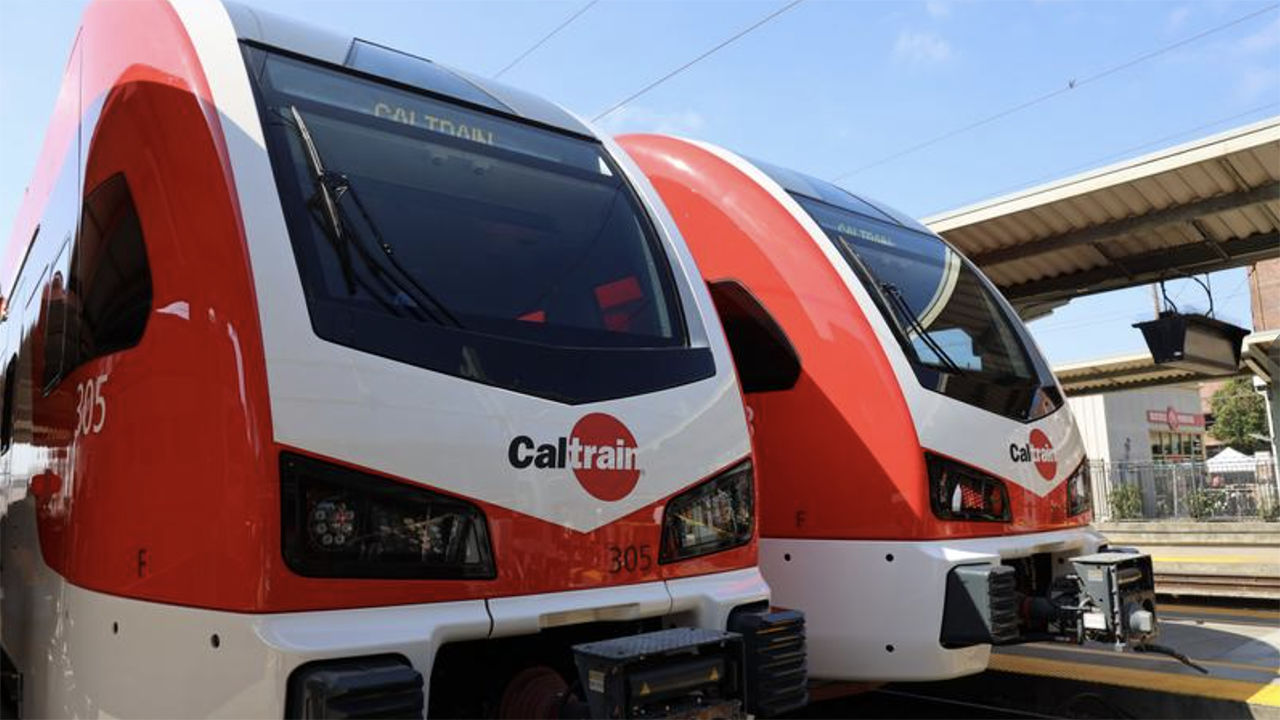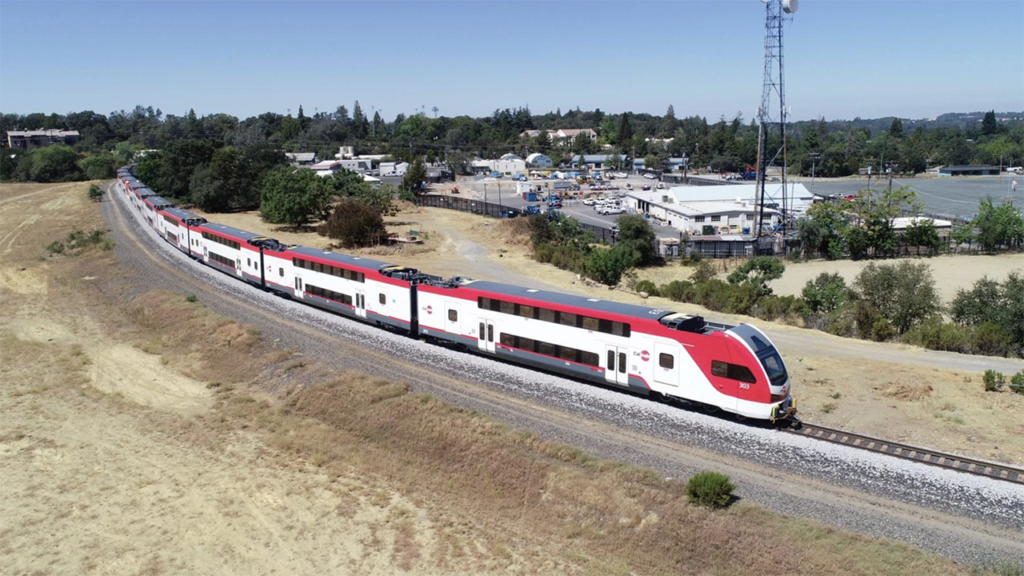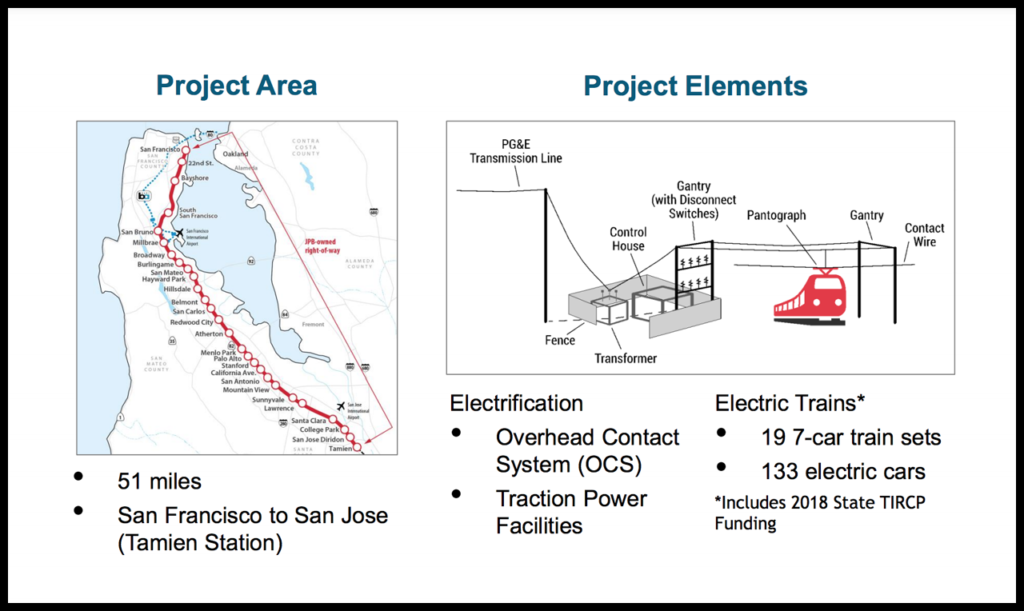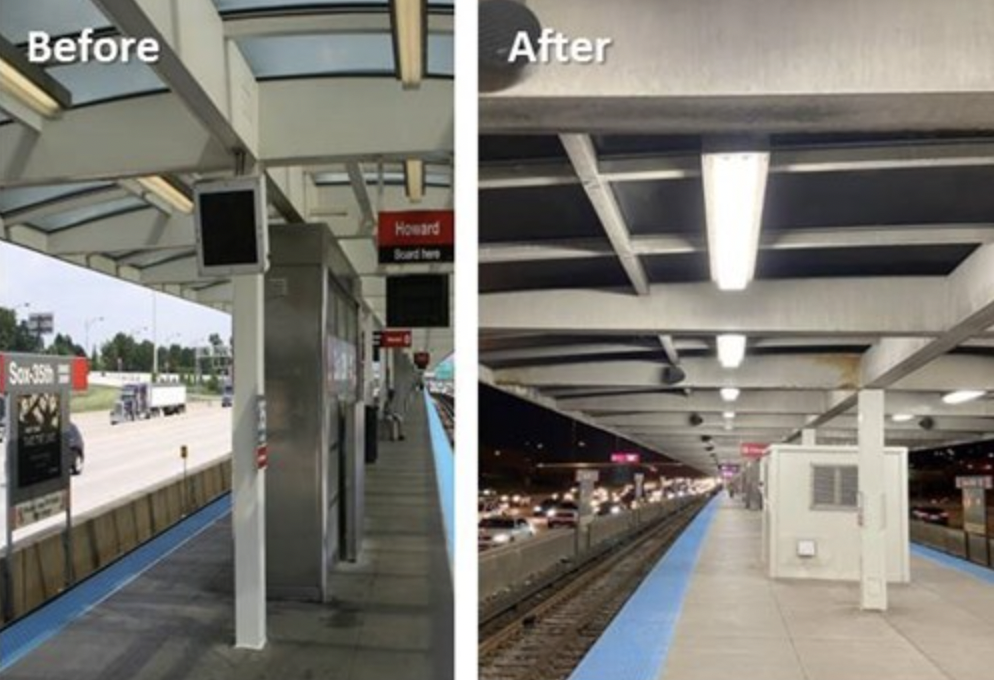
Transit Briefs: BART, Caltrain, CMAP, CTA, NYMTA
Written by Marybeth Luczak, Executive Editor
Caltrain on Dec. 7 unveiled its fall 2024 schedule for electrified service, which it said includes faster transit times and more frequent service including during weekends. (Caltrain Photograph)
The San Francisco Bay Area Rapid Transit District (BART) Board approves a new financial organizational structure. Also, California’s Caltrain releases a service plan for its fall 2024 Electrification Project rollout; Chicago Metropolitan Agency for Planning (CMAP) delivers to state legislators recommendations for keeping regional transit afloat; Chicago Transit Authority (CTA) wraps up this year’s “Refresh & Renew” project work across 29 rapid transit stations; and New York Metropolitan Transportation Authority (MTA) competes a subway station-accessibility project in Washington Heights.
BART
BART on Dec. 7 reported moving forward with changes to its financial operations “to improve efficiency and transparency” with the creation of a Chief Financial Officer (CFO) position reporting to the General Manager.
Last year, the Board of Directors, at the recommendation of the BART Office of the Inspector General, approved modifying BART’s organizational structure in an effort to focus on improving efficiency and financial operations, according to the transit agency. At its Dec. 7, 2023 meeting, the Board approved the new structure (see presentation above).
“This new financial structure brings together the functions from the Office of the Controller-Treasurer, who has traditionally reported to the BART Board of Directors, and the Performance & Budget Office, who reports to the General Manager, into one group, reporting to a new CFO position,” according to BART, which said the new structure “will create greater accountability under the General Manager to realize long-term cost savings.”
The CFO will have the authority “to implement strategic business changes to streamline BART’s financial forecasting, budgeting and reporting of financial data,” BART said.
“This is a significant reform to show we are committed to using our limited financial resources in the most efficient manner possible,” BART Board President Janice Li said. “A new CFO will help drive a culture of financial discipline as we navigate economic uncertainty.”
“This is a tremendous step for BART and reflects how well the Office of the Inspector General recommendation for a CFO structure was embraced,” said Claudette Biemeret, BART’s Inspector General. “I applaud the BART Board and Executive Leadership for taking on this change. CFO leadership is crucial to transparency and accountability in the use of public funds.”
BART General Manager Robert M. Powers has hired a consulting team to develop a roadmap for implementing the financial organization structure, according to BART, which noted that the agency “will move quickly” to identify and onboard a new CFO role. Creating a CFO position, it added, requires state legislation to amend the BART Act.
Caltrain

Caltrain on Dec. 7 unveiled its fall 2024 schedule for electrified service, which it said includes faster transit times and more frequent service including during weekends.
The service is arriving two years later than planned. The commuter railroad’s $2.4 billion electrification project is upgrading and electrifying its double-track system from the 4th and King Station in San Francisco to the Tamien Station in San Jose and replacing trains. Caltrain awarded Stadler a $551 million contract to supply 16 six-car EMUs in August 2016 with an option to extend these sets to seven-car trains exercised in December 2018. The 110-mph-capable trainsets have been built at the manufacturer’s plant in Salt Lake City, and there are options worth $385 million under the original contract to supply up to 96 additional railcars. The EMUs will replace F40 diesel locomotives—approximately 75% of Caltrain’s diesel fleet—which entered service in 1985. Its newer locomotives will be retained to operate the non-electrified Dumbarton extension and services south of Tamien.

The finalized service plan reflects community input on the proposed service plan that was announced in October, as well as responses from Caltrain’s customer survey and general population study. According to Caltrain, survey respondents’ top priorities were faster and more frequent service, with an emphasis placed on improved weekend service. The new service plan, it said, now includes more frequent weekend service, with trains running every 30 minutes, compared to hourly today.
Weekday peak period service will feature four trains per hour running in each direction, including an express train running between San Jose and San Francisco in under an hour. Local service times will be reduced from 100 minutes to 75 minutes, and travel time from Southern Santa Clara County (Gilroy/Morgan Hill) to San Francisco will be cut by nearly 30 minutes.
According to Caltrain, as ridership and revenue continue to grow, it will have the capacity for even more regular service as a result of the electrification project, with the capability to run up to six trains per hour during the peak. Caltrain said that since last year, its average weekday ridership has increased by 14%.
“With electrified Caltrain service now less than a year away, it is exciting to see a new schedule in place that will allow riders to get to their destinations quicker and more often,” Caltrain Board Chair Jeff Gee said. “While there is still a lot of work ahead of us, the vision of greener, quieter and more efficient trains will soon be a reality.”
CMAP
The Chicago Sun-Times on Dec. 7 reported that Illinois lawmakers must consider new taxes, consolidating three regional transit agencies—Chicago Transit Authority, Metra commuter rail, and Pace bus service—under one Board, and changing fee structures to address the transit fiscal crisis, according to a CMAP report prepared at the General Assembly’s request.
“Chicago-area public transit faces a crisis when federal COVID-19 dollars run out in two years, forcing transit agencies struggling with reduced ridership to make major service cuts,” according to the newspaper, which said CMAP sent its set of policy recommendations to state lawmakers on Dec. 7. “Lawmakers now face politically tough choices to raise $1.5 billion in new funding and implement sweeping organizational reforms recommended by the report, called the Plan of Action for Regional Transit” (see above).
According to the Chicago Sun-Times, state Rep. Eva-Dina Delgado and state Sen. Ram Villivalam, both Chicago Democrats, “say they will begin drafting a [transit] bill while holding a series of public hearings across the state next year. They hope to have a transit bill passed by 2026, when federal COVID-19 dollars run out and Chicago-area transit agencies will face a combined $730 million deficit.”
CTA

Scheduled station repairs and improvements in 2023 were completed ahead of schedule and within the $6.5 million budget, CTA reported Dec. 7. The transit agency’s Refresh & Renew program wrapped up work at 29 rail stations and 14 bus turnaround areas throughout the city.
Created in 2019, the annual Refresh & Renew program helps to keep stations in a state of good repair with routine maintenance that improves “the safety, security, and the overall look and feel of facilities,” CTA said. Some of the more comprehensive improvements made as part of this program include concrete repairs, removal of outdated fixtures and equipment, repairs to utility and plumbing lines, and more. Work also includes smaller cosmetic upgrades such as painting and replacing sheet metal or damaged signage, lighting upgrades, cleaning, repair of surfaces (e.g., columns, walls, railings, fencing/gates, platform fixtures, etc.), and power washing.
According to CTA, the following 29 CTA rail stations were part of the 2023 program:
- Red Line: Sox-35th, Howard, Sheridan, Addison, Clark/Division
- Blue Line: Jefferson Park, Irving Park, Belmont, Logan Square, Division, Monroe
- Green Line: Laramie, Cicero, Indiana, 35th-Bronzeville-IIT
- Brown Line: Armitage, Chicago, Francisco, Montrose, Irving Park, Addison
- Orange Line: 35th/Archer, Halsted
- Pink Line: 54th/Cermak, Pulaski
- Purple Line: Linden, Main St.
- Loop Elevated: Merchandise Mart, Washington/Wells
“Providing our customers and employees with a safe and comfortable transit environment is at the top of our priorities, and the Refresh & Renew program is a vital tool in helping us deliver on that promise,” CTA President Dorval R. Carter Jr. said. “More than just day-to-day cleaning, which has been increased system-wide in 2023, this program also helps us as an agency be more efficient by ensuring personnel thoroughly inspect each location and address repairs and upgrades that are needed both proactively and immediately—all at once.”
In other CTA news, the agency is developing a chatbot for customer assistance on its website.
New York MTA

MTA has competed a station-accessibility project at the Washington Heights 181st Street Station on the A Line. It is part of a package of eight subway stations to be made accessible this year.
The 181st Street Station had two new elevators installed to take customers from the lower mezzanine to the platform, and a new Americans with Disabilities Act (ADA)-compliant ramp added making the station entrance at Overlook Terrace accessible. The elevators include a new fire alarm system, smoke and heat detectors, and cameras inside the elevator cabs—all to improve safety, according to MTA. Each elevator is also equipped with an emergency two-way communication system that gives riders the ability to communicate with dispatchers in the event of an emergency via standard voice communications or visually by answering on-screen questions. A Federal Transit Administration grant fully funded the ADA upgrades, MTA said.
Additionally, new mosaic artworks commissioned by MTA Arts & Design are located near the new elevators (pictured) and above the two staircases that lead to the northbound and southbound platforms.
MTA said it prioritized expanding accessibility improvements in the subway during the height of the COVID-19 pandemic when ridership decreased, and it completed 15 projects at that time. With the addition of the Washington Heights 181st Street Station project, there are now 145 accessible stations and 27 stations in construction for accessibility upgrades, five of which are expected to be finished by the end of 2023, according to the transit agency.
“The MTA system includes many architectural gems,” MTA Chair and CEO Janno Lieber said. “This station–which is listed on the U.S. Register of Historic Places—is one of them. It dates back to 1932, and finally, we’re bringing it into the 21st century with two brand new elevators.”
“Newly accessible stations like 181 Street A are the fruits of our efforts to execute projects better, faster, and cheaper through innovative delivery methods like project bundling,” MTA Construction and Development President Jamie Torres-Springer said. “We are on track to complete this particular eight-station package of ADA upgrades, which will greatly improve accessibility not just in Upper Manhattan but throughout our transit system.”
“Due to the unique geography of Washington Heights, this station has had elevators for as long as I can remember, but never an accessible path to actually get onto the train,” MTA Chief Accessibility Officer Quemuel Arroyo said. “For wheelchair users and others who need step-free access, the journey stopped at the mezzanine. That changes today [Dec. 7], with two new elevators making train service at this station fully accessible, a big win for Washington Heights and a big win for accessibility.”



